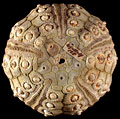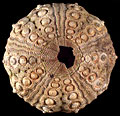The Echinoid Directory
Goniocidaris Desor, in Agassiz & Desor 1846, p. 337
[=Stephanocidaris Agassiz, 1863, p. 18 (objective); =Adelcidaris Cotton & Godfrey, 1942, p. 217, (nomen vanum); ?=Delocidaris Philip, 1964, p. 464, type species Goniocidaris prunispinosa Chapman & Cudmore, 1928
See also Goniocidaris (Aspidocidaris) Mortensen, 1928; Goniocidaris (Cyrtocidaris) Mortensen, 1927; Goniocidaris (Discocidaris) Doderlein, 1885; Goniocidairs (Petalocidaris) Mortensen, 1903 ]
| Diagnostic Features |
|
|---|---|
| Distribution | ?Upper Cretaceous (Maastrichtian), western Europe; Miocene to Recent, Indo-Pacific. |
| Name gender | feminine |
| Type | Cidarites tubaria Lamarck, 1816, p. 57, by subsequent designation of Mortensen, 1928, p. 150. |
| Species Included |
|
| Classification and/or Status |
|
| Remarks |
|





